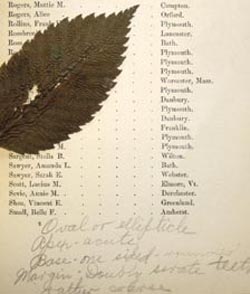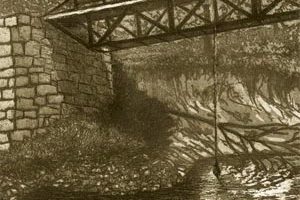by Alice Staples, Archives and Special Collections Librarian
How many alumni remember the assignment: walk around campus looking for specially marked trees and other plants and recording detailed information about each? Many alumni remember Dr. Herbert H. Lamson, a.k.a. “Lammie,” taking his classes out and about to study the local flora on campus and in Langdon Park. In the PSU archives I found the notes of one Grace Hoitt, who worked on this same assignment around the turn of the century-the 20th century, that is.
The University’s archive includes catalogs for most years from 1871 through the present. These catalogs are the documented history of the institution, reflecting changes in curriculum, residence life, campus buildings, rules and regulations, and more. As with a yearbook, there is an expectation that an institution’s archive will contain these and other regular publications. But the rare gems of the collection are the personal items that give a glimpse into the daily lives of students at Plymouth.
Grace Hoitt left behind a New Hampshire State Normal School catalog from 1889–1890, the crumbling pages revealing dried leaves and the following notes penciled in:
Elm leaf—ovalor ellipticle[sic] apex –acute,base –one sided rounded, margin –doubly serate teeth, rather course[sic]
Lilac—ovate,apex acute, base slightly heart-shaped, margin entire
Jill-over-the-ground—roundish leaf,apex –blunt,base–heart-shape, margin scalloped
On page 25 of the catalog, the circular includes a description of the campus and a list of courses offered. Under “Natural Science” is the following description:
Botany. Structural botany: flora of the locality,with preparation of herbarium, and at least 25 written analyses.
Perhaps this was the class for which Grace Hoitt was completing the assignment.
The catalog also includes the following description of the town of Plymouth, with special mention of the elm trees now gone except for a leaf that Miss Hoitt pressed between the notebook’s pages:
“In scenery, Plymouth is remarkable for the beauty of its meadows, through which the Pemigewasset winds, and for the grace of its elm trees. Even the hurrying and careless visitor will have his attention arrested here and there by a faultless one, standing out alone over its private area of shadow, seemingly an ever-gushing fountain of graceful verdure.-Starr King
The scrapbooks, penciled notes, and observations of people like Grace Hoitt, bring the past alive for the 21st-century researcher.
As I was weeding my garden this summer, pulling out handfuls of a plant with small purple flowers and roundish leaves with scalloped margins, I connected in a very real sense with Grace Hoitt and with her notes and detailed description of Jill-over-the-ground. And I wondered, who was Grace Hoitt?
If you have information about this former Normal School student, I’d like to hear from you. Contact Alice Staples at (603) 535-2961 or astaples@plymouth.edu.
The Day Mrs. Kennedy Came to Town
by Caitlin Stevens
The primary season is upon us, and presidential hopefuls and the media have descended on New Hampshire once again. The candidates and their ambassadors have a long history of visiting the colleges and universities of New Hampshire, including Plymouth State. An exhibit called “Memories of Presidential Primaries Past” at the Michael J. Spinelli Jr. Center for University Archives & Special Collections highlights the important figures who have visited the University to campaign for themselves or for others. Among the latter was Rose Kennedy.
Kennedy came to Plymouth Teachers College to speak about her son, Senator John F. Kennedy. Claira Pirozzi Monier, class of 1962, remembers her visit clearly. “I was very impressed with her graciousness and her sophisticated appearance,” said Monier. “She had a relaxed, humorous, and vivacious manner.”
Monier was majoring in secondary education, concentrating on social science, and was the co-chairman of the Plymouth Teachers College (PTC) Young Democrats. Although at age 19 she could not vote (in 1960, the voting age was 21), she planned to teach government and felt that “participation in the 1960 presidential primary seemed the ideal opportunity for more personal involvement.” This was before the years of widespread student activism, but Monier and her fellow Young Democrats already saw John F. Kennedy as “a youthful, energetic candidate who had much to offer our country.”

Mrs. Kennedy (center) with Claira Pirozzi Monier and G. Allen Foster, chairman of the Plymouth Area Democratic Party (right). Photo courtesy of PSU Archives.
After a luncheon hosted by then PTC President Harold Hyde and attended by several prominent faculty members, including James Hogan, Kennedy gave a speech to the Plymouth Teachers College community. She spoke of her son’s many qualifications for the job of president and warned that without proper leadership, the country could lose its leadership position in world politics. She pointed out that the U.S.S.R. was surpassing the United States in the areas of space exploration and military developments. Monier remembers Kennedy concluded her speech “by urging everyone to vote, since it is a privilege every U.S. citizen enjoys.”
Although not every candidate who visits or sends an ambassador to PSU goes on to become president, it is an interesting part of our history and one that should be preserved. It is in this spirit that the Spinelli Center continues to assemble and maintain a collection of photographs, memorabilia, and articles that tell the story of the presidential primaries and how they came to Plymouth State.
Caitlin Stevens,class of 2007, is a former student worker and intern of the Michael J.Spinelli Jr.Center for University Archives & Special Collections at Lamson Library. A native of Manchester, NH,she is currently pursuing a master’s of library science, with a concentration in archives management, at Simmons College.










